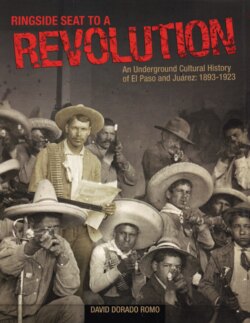Читать книгу Ringside Seat to a Revolution - David Dorado Romo - Страница 36
На сайте Литреса книга снята с продажи.
Оглавлениеtrapped in the same stratosphere that most everyone
else is.
That’s not to suggest that Aguirre believed Teresita
possessed supernatural abilities. Aguirre believed there
was a scientific explanation for every single one of
Teresita’s mysterious powers, including astral projec-
tion. Aguirre argued that the souls of human beings
have different densities, which affect their rate of travel.
“Some spirits are so dense that they can only stay on
earth,” he explained. “While
the soul of others is so spiritu-
alized that they can reach all
the heavenly bodies, no matter
how ethereal, and can travel
instantly through great dis-
tances, just as light travels
faster than heat, heat faster
than electricity, electricity
faster than sound.”50
During the nineteenth
century, science was used to
bolster not only spiritism—
and its belief that all spiritual
phenomena have a scientific
explanation—but all other
kinds of philosophical and
political worldviews that were
often mutually incompatible.
Marxists believed that scientif-
ic laws of economics foretold
the inevitable collapse of capi-
talism. Eugenicists believed that
the science of phrenology, cran-
iometry (head reading) and
psychometry (I.Q. testing)
proved the superiority of the
white race. In turn-of-the-cen-
tury Mexico, a small oligarchic
group of rich businessmen,
hacendados and Díaz cronies called themselves Los
Científicos—“The Scientists.” They believed that the
latest evolutionary theories of survival of the fittest
applied to the society at large—Social Darwinism—
gave them the right to place themselves at the top of
the social order. The Científicos also believed in
Comptean Positivism which, in their view, justified
technological, scientific and material progress no mat-
ter what the social costs.
The spiritists, on the other hand, believed in a
different kind of evolution and progress. They saw, as
one historian put it, “the evolution of worldly society
as never ending progress toward the perfection of a
human utopia overseen by a Supreme Being.”51 In
other words, just as individuals progressed from a
lower plane to a higher plane until they finally
reached union with God, countries could do the same
as well.52
In 1896, El Independiente
published a book in serial
form entitled Tomóchic,
where Aguirre spelled out
his spiritualist vision of
things. “All historical periods
are in a continual state of
evolution towards the
greater good of humanity,”
the book began. “Tomóchic
is the latest manifestation of
popular forces that will
destroy the tyranny of Mr.
Porfirio Díaz which is
presently murdering Yaqui
children; it is the beginning
of a period of true spirituali-
ty; it is the beginning of an
era in which women will be
emancipated, for its hero-
ine—without intention on
her part—was a young
woman; it is the awakening
of the poor, the illiterate, the
lepers and the socially segre-
gated.”53
Tomóchic is undoubted-
ly one of the strangest
books published in El Paso
during the turn of the cen-
tury. It’s a melange of history, spiritism, revolutionary
theory and a primitive form of feminism. To make
matters even more complicated, Aguirre tried to
ground all of these on the latest theories of astrono-
my, electromagnetism and nuclear physics.
Apparently anticipating the discovery of black holes
by decades, Lauro hypothesized the existence of
heavenly bodies in the universe unknown and invis-
ible to man who exert forces over matter so powerful
31
The books Tomóchic and the Role of the
Saint of Cabora (The Mexican Joan of Arc)
and The Necessary President were
published in serial form by Lauro Aguirre
by his newspaper El Progresista in 1901.
(Southwest Collection, Texas Tech
University.)
50
Aguirre and Urrea, Tomóchic, p. 71.
51
Vanderwood, The Power of God, p. 178.
52
Perhaps it was no accident that Lauro Aguirre, Francisco Madero, Pascual Orozco, José de la Luz Blanco, Braulio Hernández and several other
fronterizo revolutionaries who would later operate out of El Paso and Juárez were adherents of either spiritism or Protestantism. Both were
imported and relatively new religious worldviews within turn-of-the-century Mexico.
53
Aguirre and Urrea, Tomóchic, p. 3.
